Cuscuta Herba, Dodder herbCassuthaAftimoon (Unani) Akash Bel (Hindi) Tu Si Cao (TCM) |

|

|
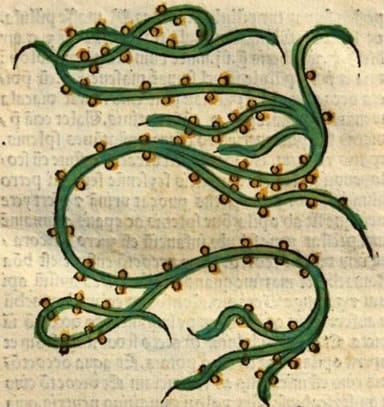
|
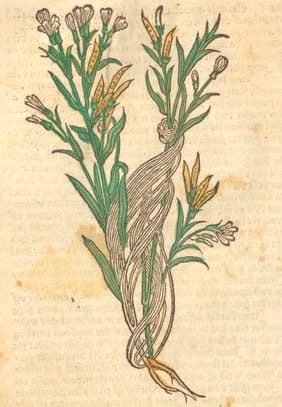
|
|
Herbarius latinus, Petri, 1485 |
Gart der Gesundheit, Cuba, 1485 |
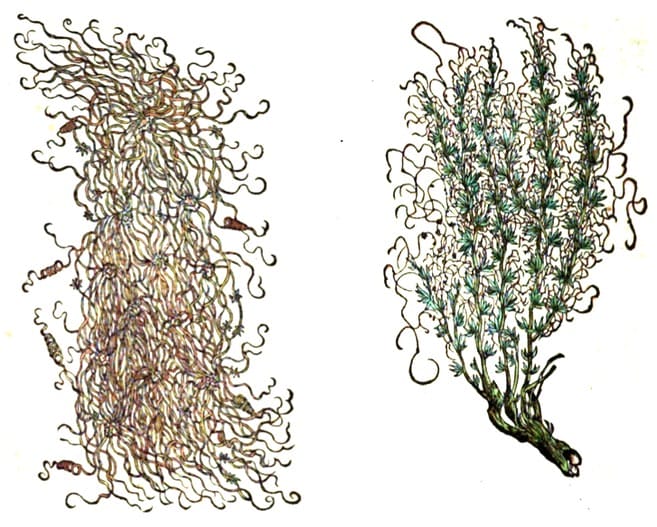 Left: Dodder, Cuscuta ; Right: Dodder of Thyme, Epithymum
Left: Dodder, Cuscuta ; Right: Dodder of Thyme, EpithymumKreutterbuch, Matthiolus, 1586
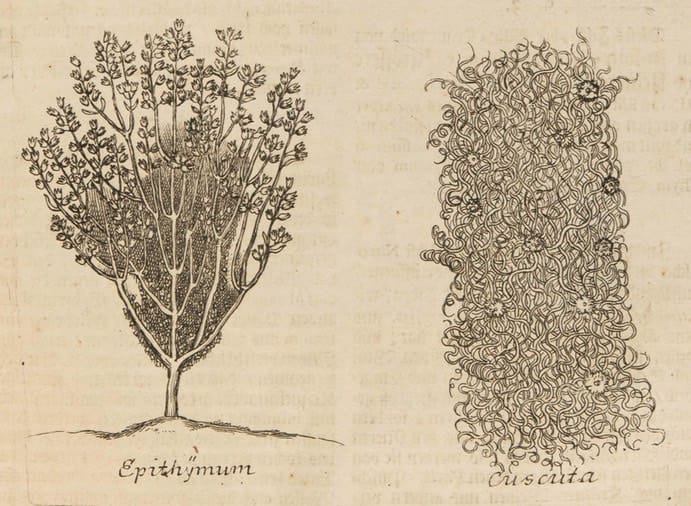 Left: Epithymum; Right: Cuscuta
Left: Epithymum; Right: CuscutaMuseum Museorum, Valentini, 1704
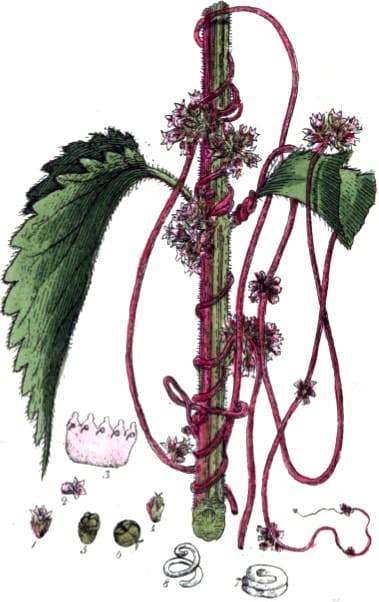
|
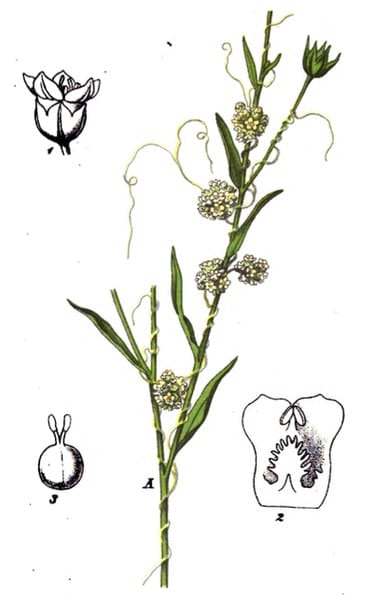
|
|
E. europea British Phaenogamous Botany, Baxter, 1834 |
C. vulgaris Flora von Deutschland (16), Kohler, 1884 |
Icones Plantarum Medicinalium. 1788
Botanical name:
Cuscuta spp.
The Dodder of the West is supplied by C. europea, C. epithymum (syn. C. minor), C. vulgaris, C. reflexa
Greater and Lesser types, as well as White and Red types were recognised.
It is a parasitic herb on Hops, Nettle and Flax, among others. Schroder said the whole herb in flower was used, chiefly that from Flax. Unani regularly collects Dodder from plants including Zizyphus mauritiana, Acacia nilotica etc.
Two types were known in the West:
1. Epithymum (best, collected from Thyme; best for the Spleen and Melancholy)
2. Cuscuta (collected from Flax, Nettle, Hops and numerous other plants; better for the Liver)
Parts used:
Herb (most used in the Western tradition)
See also Dodder Seed
Temperature & Taste:
Warm, dry. Bitter, slightly Pungent
“It is slightly Hot in the beginning of the First degree and Dry in the last phase of the Third degree. It is, however, composed of constituents with contradictory potencies” (Avicenna)
Classifications:
2A APERIENT. 2B ATTENUATERS. 2F. PURIFYING. 2G. CLEANSING. 2H. CARMINATIVE. 2I. ANTISPASMODIC
3B. FEBRIFUGE & ANTIPYRETIC. 3E. DIURETIC. 3G. EMMENAGOGUE
4a. CEPHALIC. 4e. STOMACHIC. 4f. SPLENETIC. 4g. HEPATIC
Preparers and Purgers of Melancholy
Preparers and Purgers of Phlegm
Laxative, Purgatives and Cathartics
Uses:
1. Benefits the Spleen, Clears Melancholy:
-mainly used for the Spleen and Melancholy; Depression, Mania, Mental Illness, Schizophrenia
-opens obstructions of the Spleen, clears Black Jaundice, good for Scabs, Ulcers, Leprosy, hard Tumors from Melancholy.
-purifies the Blood, resolves Swellings
-important for Fibroids and Cancer
-Liver and Spleen obstructions and hardness
-regarded as Nutritive and tonic in Unani
-“Dodder is a purifier and it removes tenuously superfluous matters from the vessels” (Avicenna)
-“When taken orally with vinegar, it relieves hiccough and removes hepatic and gastric obstructions” (Avicenna)
2. Benefits Brain and Nerves, Clears Wind and Damp:
-Epilepsy, Paralysis, Facial Paralysis, Hemiplegia, Numbness; Insensibility in Unani
-Myalgia, Arthritis, Rheumatism and Sciatica
-useful in diseases of the Brain and Nerves
3. Clears Damp, Promotes Urine:
-Strangury, Jaundice, Dysentery
4. Tonifies Yin and Yang, Secures the Essence:
-Impotence, Infertility, Oligospermia
-regarded as having anti-aging effects
-weakness, palpitations and sensitive digestion in the elderly
-‘It has also a strengthening property’. (Pemell, 1652)
-Diabetes
5. Stops Bleeding:
-Bleeding from the Bowels, Coughing and Spitting Blood, and Uterine Bleeding associated with Heat. (TCM)
-is used to promote menstruation
6. Clears Phlegm, Stops Cough:
-Asthma, Bronchitis (Ayurveda)
7. Kills Worms
8. Externally:
-distilled water clears the Sight if dropped into the Eyes. (Pemell, 1652)
-apply a paste of Dodder for Itchiness. (Unani)
-Baldness and Alopecia areata, grind the herb into a paste with water and apply twice daily to the Scalp for one month; or decoct the herb in Sesame oil and apply to the scalp twice daily. (Unani)
-Cataract, mix a little sugar in Dodder juice, filter, and drop into the eye.
-decoction is good to wash Wounds. (Unani)
-pains of the Sinews, Dodder (of Thyme) is applied as a liniment with vinegar
-fresh herb is beaten and applied to Scrofulous tumors. (Grieves)
-herb is fried in oil and made into a paste for chronic Ulcers (Unani)
-applied topically to Eczema (India).
Dose:
1. It shouldn’t be decocted for long, usually added in the last 10 minutes and steeped after removing from the heat.
2. To ‘dissolve Black Bile’, it is taken with sweet wine or Hydromel (Galen)
3. Given with salt for Liver disorders, respiratory diseases, and those with gas in the diaphragm (Galen)
4. Lower doses are used in Summer.
Decoction: 5–15 grams (added towards the end of decocting and then steeped after removing from the heat)
Powder: 1.5–5 grams
Preparation:
“The roasted dodder causes Constipation and stops Leucorrhea”. (Avicenna)
Correctives:
1. Dodder herb is corrected with Mastic, Licorice, or Raisins, or a decoction of Raisins, Violets or Borage (these mitigate its dryness).
2. Tragacanth or Almond oil also mitigate its dryness.
3. Mesue listed Whey, Hydromel, Indian Salt, Rock Salt, or Black Myrobalan to correct and enhance purgation of Melancholy.
4. Chicory and Lemon, or Chicory and Oxymel (Unani)
5. Because it works slowly, it is enhanced with Rock Salt, Ginger, or Black Hellebore
Substitutes:
1. The Barefoot Doctors Manual (Official Para-medical Manual of China) suggests that the herb and seed may be used interchangeably. Some western writers said the Seed could be used in place of the Herb.
2. Avicenna used Fumitory as a replacement for Dodder if the body was excessively Hot.
3. Dodder seed may be used if the body is excessively dry or in cases with Yin deficiency.
4. Wormwood, Turbith (Unani)
5. Stoechas, Polypody when used for Melancholy
6. For Black Bile, Turbith with one-third Thyme (Al-Biruni)
7. Wormwood and Thyme
Main Combinations:
Dodder & Wormwood
1. To Purge Melancholy humor:
i. Dodder with Black Myrobalan, Polypody, Turbith and Senna (as in Decoction of Dodder, Rhasis). This was one of the most commonly used medicine to purge the Melancholy Humor, and was used for Melancholy, Dementia, Fibroids, Cancer etc. Used in the long-term treatment of Cancer, it was said to lengthen life.
ii. Similarly used to the preceding is Syrup of Dodder of Mesue: Dodder, Yellow, Black, Emblic and Belleric Myrobalans, Polypody, Licorice, Agaric, Thyme, Fumitory, Aniseed, Sweet Prunes, Raisins, Tamarind.
2. Melancholy:
i. 7-14 grams of Dodder with Honey and Salt (Avicenna)
ii. Dodder with Senna, Aniseed, Licorice, Prunes (Pemell, 1652)
iii. Dodder with Balm, Rosemary, Borage, Bugloss, Yellow Myrobalan, Thyme, Senna, Polypody (Pemell, 1652)
iv. and Psychosis, Dodder with Agaric, Turpeth, Stoechas, Polypody (Pills of Dodder, Unani)
v. Dodder with Wormwood, Borage and Fumitory.
vi. Dodder with Balm, Rosemary, Borage, Yellow Myrobalan, Thyme, Senna, Polypody
vii. Dodder with Agaric, Polypody, Black Myrobalan, Aniseed
3. To purify the Blood:
i. Dodder with Fumitory and Chicory
ii. Dodder with Borage and Fumitory
4. To Purge Bile:
i. Dodder with Wormwood
ii. Dodder with Yellow Myrobalan, Rhubarb
5. Chlorosis, Dodder, Elecampane, Balm, Agrimony
6. Jaundice, Dodder with Agrimony, Hops
7. Arthritis of the Hip, Dodder seed with Sage (Pemell, 1652)
8. Children’s Fever, Dodder with Wormwood (Pemell, 1652)
9. Quartan Fever (Malarial Fever), Dodder with Lapis Lazuli (Pemell, 1652)
10. Alopecia, to promote Hair growth, Dodder with Eclipta alba
Major Formulas
Potion for Unulcerated Cancer
Decoction of Dodder of Thyme (Mesue)
Decoction of Dodder of Thyme (Rhasis)
Decoction of Thyme (Mesue)
Syrup of Dodder of Thyme (Mesue)
Syrup of Fumitory Compound (Augustana)
Tincture Against Schirrus of the Spleen
Powder Purging Melancholy (Fuchs)
Electuary of Dodder
Electuary of Dodder and Fumitory (Mesue)
Proven Electuary Against Vitiligo
Triphera of Dodder of Thyme (Mesue)
Triphala Electuary of Dodder (Unani)
Pills for Melancholy (Unani)
Cautions:
1. Use cautiously during Pregnancy.
2. Harmful for the Lungs in excess (Unani)
3. Avicenna said ‘It produces pain, vomiting and thirst in persons having excessive Bile’.
Toxicity:
Acute toxicity tests showed no mortality at up to 5000mg/kg of the extract given to rats.
Subacute Liver toxicity was noted at 200mg/kg and 500mg/kg in rats.
Main Preparations used:
Distilled Water of the whole Plant
-
More Info
-
History
-
Research
|
‘This is the Arabic form of the Greek word [?], “growing on thyme,” a name applied by Dioscorides to a plant growing in Cappidocia and Pamphylia, which was used for purging the body of pituitous humors and black bile, (iv. 172). His description of it is so unsatisfactory that it is doubtful whether he is speaking of the flowers of a kind of thyme, or of a parasitic plant growing on thyme. Pliny (26, 35), commences by speaking of Epithymon as the blossom of a sort of thyme similar to Savory, but ends by saying— “Some persons, again, give a different description of epithymon: according to them, it is a plant without a root, diminutive, and bearing a flower resembling a small hood, and of a red colour.” Epithymon is generally identified with Cuscuta Epithymum, Linn., the Lesser Dodder, a parasitic plant |
upon Heath, Furze, Thyme and other small shrubby plants. (See Fl. Br. 283; Fl. Dan. t. 427.) The plant used medicinally in India as Aftimun is imported from Persia, and appears to be a larger species, probably C. europea, Linn., which is a native of Europe and of Western and Central Asia. Mahometan physicians consider this drug to be alterative and depurative, a purge for bile and black bile, useful in all affections of the brain such as fits, melancholy, insanity, &c. They also describe it as carminative; and apply it locally as an anodyne. The author of the Makhzan-el-Adwiya devotes a whole folio page of small print to a description of its properties and uses. In modern medicine the different species of Cuscuta are no longer used.” (Pharmacographia Indica, Dymock, 1891) |
